6.Chinese art中国传统文化 中国艺术.ppt
合集下载
6Chineseart中国传统文化中国艺术PPT课件
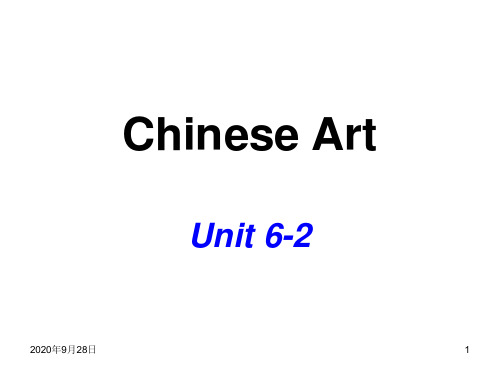
arrived in China, though it did not become
popular until the 4th century. At this point,
Chinese Buddhist art began to flourish, a
process which continued through the 20th
done on silk until well after the invention of
paper. 2020年9月28日
7
Terracotta Army (兵马俑)
• The terracotta figures, dating from 210 BC, were discovered in 1974 by some local farmers near Xi'an, Shaanxi province, China near the Mausoleum of the First Qin Emperor. (秦始皇陵). The figures vary in height (183–195 cm - 6 ft– 6 ft 5in), according to their role.
2020年9月28日
8
西汉霍去病墓石雕 东汉马踏飞燕(甘肃张掖出土)
2020年9月28日
9
隋朝的鎏金菩萨像
山西五台山南禅寺唐代彩塑
2020年9月28日
10
元代释迦牟尼白瓷佛像
明代鎏金观音坐像
2020年9月28日
11
History of the Art
• Buddhist architecture and sculpture thrived in the Sui and Tang dynasty. Of which, the Tang Dynasty was particularly open to foreign influence. Buddhist sculpture returned to a classical form, inspired by Indian art of the Gupta period. Towards the late Tang dynasty, all foreign religions were outlawed to support Taoism.
中国传统艺术中英文介绍sophia ppt课件
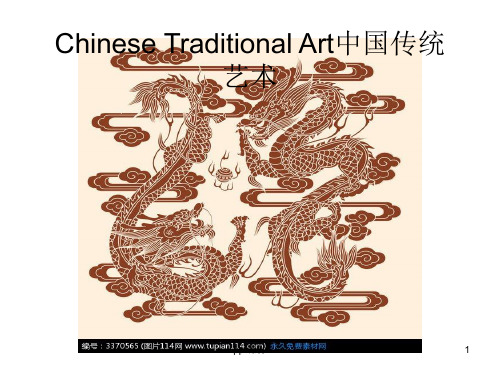
起源于中国的剪纸,历史悠久,一直深受中国老
百姓的欢迎。第一幅剪纸作品可以追溯到南北朝
时期(公元386-581).剪纸的产生和传播与中
国农村的节日有着密切的联系。人们在婚礼或过
节时在墙上、窗户、门上贴上剪纸以增强节庆的
气氛。
ppt课件
8
CONTENT
• Chinese papercuts are rich in content. T he auspicious designs symbolize good lu ck and the avoidance of evil. The child, lo tus and bottle gourd designs suggest a fa mily with a large number of children an d grandchildren. Domestic birds, livesto ck, fruit, fish and worms are also familia r objects depicted by Chinese farmers. P apercuts made in different areas have di fferent characteristics. Shanxi window p apercuts are simple and bold; papercuts from Hebei Province and Shanxi Provinc e are bright in color; papercuts in southe rn provinces are delicate and fine.
ppt课件
4
中国剪纸
Chinese Papercuts
中国传统文化知识介绍PPT课件

06
中国美食
八大菜系
• 鲁菜:以济南菜为主,大方高贵,做工精细,官府菜。 • 粤菜:以广州菜为主,追求新鲜,清淡,味鲜。 • 川菜:以四川菜为主,辣味浓郁,口味多变。 • 苏菜:以江苏菜为主,刀工精细,菜品鲜美,注重本味。 • 闽菜:以福建菜为主,烹调技艺高超,多海鲜。
地方特色菜
北京烤鸭
上海小笼包
四川麻婆豆腐
广东白切鸡
湖南口味蛇
• 以北京填鸭为主料 ,用果木烤制而成,皮 酥肉嫩,味道鲜美。
• 以上等猪肉、鸡汤 为主料,蒸制而成,皮 薄馅嫩,汤汁浓郁。
• 以豆腐为主料,加 入豆瓣酱、花椒粉等调 料烧制而成,麻辣鲜香 。
• 以三黄鸡为主料, 浸熟后切块,配上姜丝 、葱花、酱油等调料食 用,口感鲜嫩。
中国医学
中医基本理论
强调整体观念
1
• 中医认为人体内部与外部环境是一个有机 的整体,人体内部的五脏六腑、气血阴阳与
外部环境相互影响、相互作用。
强调气血阴阳平衡
2
• 中医认为人体内部的气血阴阳平衡是保持 健康的重要因素,失衡会导致疾病。
强调辨证施治
3
• 中医通过望、闻、问、切四种方法对病人 进行诊断,然后根据不同的病情制定不同的
民间故事
• 如《老鼠嫁女》、《葫芦娃》等。
民间歌谣
• 如《茉莉花》、《刘三姐》等。
04
中国艺术
国画
特点
• 国画注重表达意境,讲究笔墨神韵,追求气韵生动。
分类
• 国画根据绘画题材,可分为人物画、山水画、花鸟画等。
书法
特点
• 书法强调笔画之间的呼应、连贯和韵律感,富有审美价 值。
分类
• 书法根据书写风格和技巧,可分为楷书、草书、隶书等 。
中国传统文化英语PPT课件

.
16
2 Hanfu
The classification of the Hanfu
Quju(. 曲裾)
17
2 Hanfu
广袖双绕长曲裾
广袖双绕短曲裾
.
18
2 Hanfu
Ruqun(襦裙)
.
19
2 Hanfu
Qiyaoruqun(齐. 腰襦裙)
20
2 Hanfu
Qixiongruqun(.齐胸襦裙)
21
2 Hanfu
Zhizhui(直缀) Mianfu(冕服)
.
Zhiju(直裾)
22
2 Hanfu
As a classic symbol of china , especially for Han ethnic, Han Chinese clothing has been deeply imprinted in all aspects of Chinese civilization, representing it’s gorgeous ,elegant , and rich temperament
.
14
What is Hanfu?
2 Hanfu
Hanfu means “clothing of Han people” in chinese
It refers to the pre-17th century traditional clothing of Han chinese
Hanfu has a history more than 3000years
.
1
Introduction
As we know,Chinese culture is the accumulation of Chinese history, which makes Chinese culture colorful and prosperous. If you want to have a in-depth understanding of Chinese culture , you must spend a lot of time in it, otherwise you can only get the tip of the iceberg.
最新Chinese-Art[week-6]教学讲义PPT
![最新Chinese-Art[week-6]教学讲义PPT](https://img.taocdn.com/s3/m/c95c2eb19b6648d7c0c74664.png)
lifting a foot, etc.)
A stylized routine: each move, gesture or facial expression is symbolic
Major Features of Beijing Opera
The orchestra: string and wind instruments, percussion instruments
Strategy of an Unguarded City
Major Features of Beijing Opera
Costumes:
I. The styles of the Ming Dynasty court and civil costumes
II. A garish collection of sharply
houses, temple courtyards or markets
The singing, the variations of rhythm and pitch: expressing the roles’ thoughts
and emotions of different characters in all situations
and monologue to characterize the
Chinese
personalities of the roles. The movements all have their
pattern
Art
and formula (such as: stroking a beard,
setting a hat straight, swing a sleeve,
IV. Special costumes: different colors and designs for each role based on the rank, life style and occupation
中国传统艺术资料讲解PPT文档共84页
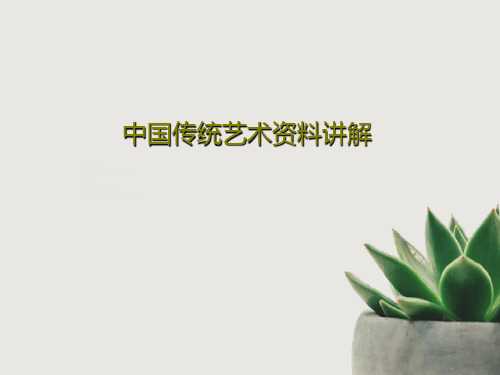
▪
26、要使整个人生都过得舒适、愉快,这是不可能的,因为人类必须具备一种能应付逆境的态度。——卢梭
▪
27、只有把抱怨环境的心情,化为上进的力量,才是成功的保证。——罗曼·罗兰
▪
28、知之者不如好之者,好之者不如乐之者。——孔子
▪
29、勇猛、大胆和坚定的决心能够抵得上武器的精良。——达·芬奇
▪
30、意志是一个强壮的盲人,倚靠在明眼的跛子肩上。——叔本华
谢谢!
84
中国传统艺术资料讲解
11、获得的成功越大,就越令人高兴 。野心 是使人 勤奋的 原因, 节制使 人枯萎 。 12、不问收获,只问耕耘。如同种树 ,先有 根茎, 再有枝 叶,尔 后花实 ,好好 劳动, 不要想 太多, 那样只 会使人 胆孝懒 惰,因 为不实 践,甚 至不接 触社会 ,难道 你是野 人。(名 言网) 13、不怕,不悔(虽然只有四个字,但 常看常 新。 14、我在心里默默地为每一个人祝福 。我爱 自己, 我用清 洁与节 制来珍 惜我的 身体, 我用智 慧和知 识充实 我的头 脑。 15、这世上的一切都借希望而完成。 农夫不 会播下 一粒玉 米,如 果他不 曾希望 它长成 种籽; 单身汉 不会娶 妻,如 果他不 曾希望 有小孩 ;商人 或手艺 人不会 工作, 如果他 不曾希 望因此 而有收 益。-- 马钉路 德。
中国传统艺术Chinese Art 中国文化 中国艺术 小学生

Chinese art
• What are special Chinese art forms? • How does these artworks represent culture?
中国画Chinese paintings
中国画是中国的传统绘画形式,
是用毛笔蘸水、墨和彩画在绢或纸上。
汉字书法 calligraphy
• 汉字书法是中国人独创的文字艺术,主要指用毛 笔书写汉字的方法。
音乐 music
• 中国古典音乐主要是用传统的乐器演 奏的,像古筝、琵琶笛子和二胡等。 音乐比较轻柔和悠扬。
舞蹈 dance
中国古典舞蹈比较优雅和柔美, 讲究神韵,很有中国特色。
戏剧 opera
• 中国传统的戏剧有京剧、川剧、粤剧等很多种。 表演的衣服和脸谱都很特别。
陶瓷 china, ceramics
中国是“陶瓷的故乡”, 在很久之前的古代就在全 世界非常有名, 甚至用中 国的英文名指代陶瓷。它 不仅精美还很有用。
青花瓷 blue and white porcelain
青花瓷是中国瓷器的现在是 很有中国特色的图案。
• What are special Chinese art forms? • How does these artworks represent culture?
中国画Chinese paintings
中国画是中国的传统绘画形式,
是用毛笔蘸水、墨和彩画在绢或纸上。
汉字书法 calligraphy
• 汉字书法是中国人独创的文字艺术,主要指用毛 笔书写汉字的方法。
音乐 music
• 中国古典音乐主要是用传统的乐器演 奏的,像古筝、琵琶笛子和二胡等。 音乐比较轻柔和悠扬。
舞蹈 dance
中国古典舞蹈比较优雅和柔美, 讲究神韵,很有中国特色。
戏剧 opera
• 中国传统的戏剧有京剧、川剧、粤剧等很多种。 表演的衣服和脸谱都很特别。
陶瓷 china, ceramics
中国是“陶瓷的故乡”, 在很久之前的古代就在全 世界非常有名, 甚至用中 国的英文名指代陶瓷。它 不仅精美还很有用。
青花瓷 blue and white porcelain
青花瓷是中国瓷器的现在是 很有中国特色的图案。
中国传统艺术中英文介绍 PPT

中国艺术的种类
• 我国传统艺术的遗产极其丰富并且辉煌。绘画、书法、音乐、 戏曲、剪纸、放天灯、陶土艺术、刺绣、皮影戏,传统美食、 传统服饰等等,中国是一个有着五千年悠久历史和文化传统 的文明古国,传统人文文化底蕴深厚。
• The heritage of traditional Chinese art is extremely rich and brilliant; there are Chinese Painting,Calligraphy, Music,Dancing, Chinese opera, Paper Cutting,Sending the sky lantern,Clay Art, Embroider , Shadow Play , Traditional food, Traditional costume. Etc. China, a ancient country of over 5,000 years of history and cultural tradition, has a profound traditional cultural foundation
Part 1 中国传统艺术 Part 2 Paper Cutting 剪纸
02~04 05~10
Part 3 Sending the sky lantern 放天灯
11~15
Part 4 Calligraphy 书法 Chinese painting 国画
Part 5
16~25 26~31
Part 6 Embroider 刺绣 Part 7 Shadow Play 皮影戏
• With their long history, papercuts, which origina ted in China, have been very popular among the ordinary people of China. The first papercut can be traced back to the Northern and Southern D ynasties (386~581) period. The initiation and sp read of papercuts had a close relationship with Chinese rural festivals. People pasted papercuts on walls, windows and doors at wedding cerem onies or festivals to enhance the festive atmosp here.
中国传统文化中国画英文PPT课件
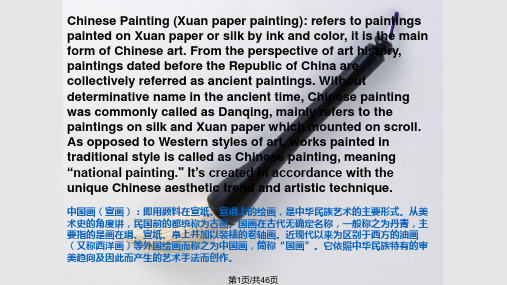
Chinese Bird-and-flower paintin第g 19页/共46页
第20页/共46页
Chinese Figure Painting
Classification according to the
technique of Chinese painting 中国画按技法划分
great freehand style大写意
第35页/共46页
第36页/共46页
第37页/共46页
第38页/共46页
第39页/共46页
Bamboo
第40页/共46页
• WWD
Paint the bamboo poles first..
第41页/共46页
Before the ink becomes dry, add the twigs and leaves.
第33页/共46页
• 1.Hold the brush handle upright and the brush tip will move right. • 笔正:笔正则锋正。 • 2.Keep the fingers firm with flexibility. • 指实:要劳实有力,还要灵活不死。 • 3.keep the palm relaxed and empty . • 掌虚:不要紧握,掌心是空的。 • 4.lift the wrist and elbow above the table to use the brush freely。 • 运笔要悬肘。
中国画(宣画):即用颜料在宣纸、宣绢上的绘画,是中华民族艺术的主要形式。从美 术史的角度讲,民国前的都统称为古画。国画在古代无确定名称,一般称之为丹青,主 要指的是画在绢、宣纸、帛上并加以装裱的卷轴画。近现代以来为区别于西方的油画 (又称西洋画)等外国绘画而称之为中国画,简称“国画”。它依照中华民族特有的审 美趋向及因此而产生的艺术手法而创作。
第二节中国传统艺术 ppt课件

22
23
六、中国象棋 les é checs Chinois
中国象棋大约起源于战国时代,根据春秋战国两军打仗创 造的战斗游戏。
中国象棋的棋盘是 正方形的,棋盘的中间 有一条“界河”,把双方 分开。两边画有线的 地方共有90个点,棋子 就放在这些点上。
24
25
中国象棋共有32个棋子,分为黑红两组,下棋的双方各 用一组,每组有将jiànɡ、士、相xiànɡ、马、车、炮pào、 兵。
50
中国画按画法可以分成:工笔画和写意画。
51
52
53
54
55
56
57
各种棋子的走法不同,如:马走日字,相走田字,车可 以横竖走等。最后谁把对方的“将”吃掉,谁就赢了。
26
七、汉字
汉字是世界上最古老的文字之一,也是世界上使用人数 最多的文字。汉字有很多,大约60 000个,常用的约有 6000个。它起源qǐyuán于记事图画,也就是距今天3400多 年的甲骨文。
27
人 休
明
湖
32
汉字的简化simplifier
由于繁fán体字难写、难记,在1949年,中国政府统一对 汉字进行简化,把2000多个繁体字简化了。
汉字简化 漢字簡化
中华人民共和国 中華人民共和國
33
八、书法 la calligraphie
书法上传统的汉字书写艺术,常见的字体有
zhuàn lì kǎi
笨,没有学问无颜见爹娘 ……” • “太阳当空照,花儿对我笑,小鸟说早早早……”
4
二胡
5
鼓ɡǔ
锣luó
6
琵琶pípá
古筝ɡǔzhēn7 ɡ
二、京剧
京剧是中国流行最广、影响最大的一个剧种,有差不多 200年的历史。京剧是一种唱、念、做、打的艺术。 唱:演唱 念:对话、独白 做:动作、表情 打:武术表演
23
六、中国象棋 les é checs Chinois
中国象棋大约起源于战国时代,根据春秋战国两军打仗创 造的战斗游戏。
中国象棋的棋盘是 正方形的,棋盘的中间 有一条“界河”,把双方 分开。两边画有线的 地方共有90个点,棋子 就放在这些点上。
24
25
中国象棋共有32个棋子,分为黑红两组,下棋的双方各 用一组,每组有将jiànɡ、士、相xiànɡ、马、车、炮pào、 兵。
50
中国画按画法可以分成:工笔画和写意画。
51
52
53
54
55
56
57
各种棋子的走法不同,如:马走日字,相走田字,车可 以横竖走等。最后谁把对方的“将”吃掉,谁就赢了。
26
七、汉字
汉字是世界上最古老的文字之一,也是世界上使用人数 最多的文字。汉字有很多,大约60 000个,常用的约有 6000个。它起源qǐyuán于记事图画,也就是距今天3400多 年的甲骨文。
27
人 休
明
湖
32
汉字的简化simplifier
由于繁fán体字难写、难记,在1949年,中国政府统一对 汉字进行简化,把2000多个繁体字简化了。
汉字简化 漢字簡化
中华人民共和国 中華人民共和國
33
八、书法 la calligraphie
书法上传统的汉字书写艺术,常见的字体有
zhuàn lì kǎi
笨,没有学问无颜见爹娘 ……” • “太阳当空照,花儿对我笑,小鸟说早早早……”
4
二胡
5
鼓ɡǔ
锣luó
6
琵琶pípá
古筝ɡǔzhēn7 ɡ
二、京剧
京剧是中国流行最广、影响最大的一个剧种,有差不多 200年的历史。京剧是一种唱、念、做、打的艺术。 唱:演唱 念:对话、独白 做:动作、表情 打:武术表演
中国艺术文化 PPT
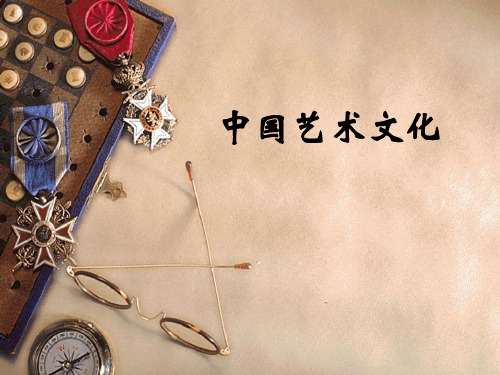
由于不少的艺术作品已被认为是高度提 炼的、被认为是异常精美的形式,而这 些美的形式也被视为人工化了的自然情 感,所以,千百年来人们仍爱写七绝、 七律,而书法艺术历千多年来至今仍绵 绵不绝,歌唱方面则人们对固定的唱腔、 传统的旋律而百听不厌。
以美的形式为塑造目标和标准尺度,忠 实于描写现实事物图景的课题便处于从 属的位置,而使现实图景的描写,也被 予以形式的美化,如京剧中醉步要美、 百纳衣也要美,其好处是将一切的事物 美化、艺术化,使人看来舒服,坏处则 是失真了。
影响所及,中国之诗文、昼等多是描绘 大自然之状貌,当中可见到人与大自然 相融合之处。
儒道互补
儒生显贵时,则兼善天下,以天下万 民之生活为己仕,穷则独善其身, 这时他们则以道家之思想处世,正如 他们心中所念繁华短促,自然永存, 于是便有出世之思想,他们为文则言 志,词曲则抒情,而绘画则重山水。
在艺术的表现上,禅以韵味胜,以精巧胜, 它是妙悟而自得。
中国艺术之特征
艺术生活化 美象征善 不尚形似重传神 艺术风格之变化没有过激或戏剧化之
改变,变化是属传统内的变迁。 重视与读书人有关之艺术,如缯昼、
书法、篆刻等,而轻视与工匠有关之 艺术,如彫刻、建筑等。
中国之文人画
多以山水为主,人在昼中所占的地位 极少。
在艺术上,禈宗使人「凝神于景」、 「心入于境」,而与自然合一的禅意, 它是感性的,但是又超越了感性。
此外,佛教为中土带来了武术,它虽 然说是以武为主,实际上不是教人技 击,而是有其艺术性的,甚至在外国 人看来,中国之套拳,似舞蹈多于武 学,不过这当中既有艺术性,也有实 用之价值在。
佛教也为中土带来了佛寺、佛塔,其 中之博大恢宏,对中国之艺术有深远 之影响。
以美的形式为塑造目标和标准尺度,忠 实于描写现实事物图景的课题便处于从 属的位置,而使现实图景的描写,也被 予以形式的美化,如京剧中醉步要美、 百纳衣也要美,其好处是将一切的事物 美化、艺术化,使人看来舒服,坏处则 是失真了。
影响所及,中国之诗文、昼等多是描绘 大自然之状貌,当中可见到人与大自然 相融合之处。
儒道互补
儒生显贵时,则兼善天下,以天下万 民之生活为己仕,穷则独善其身, 这时他们则以道家之思想处世,正如 他们心中所念繁华短促,自然永存, 于是便有出世之思想,他们为文则言 志,词曲则抒情,而绘画则重山水。
在艺术的表现上,禅以韵味胜,以精巧胜, 它是妙悟而自得。
中国艺术之特征
艺术生活化 美象征善 不尚形似重传神 艺术风格之变化没有过激或戏剧化之
改变,变化是属传统内的变迁。 重视与读书人有关之艺术,如缯昼、
书法、篆刻等,而轻视与工匠有关之 艺术,如彫刻、建筑等。
中国之文人画
多以山水为主,人在昼中所占的地位 极少。
在艺术上,禈宗使人「凝神于景」、 「心入于境」,而与自然合一的禅意, 它是感性的,但是又超越了感性。
此外,佛教为中土带来了武术,它虽 然说是以武为主,实际上不是教人技 击,而是有其艺术性的,甚至在外国 人看来,中国之套拳,似舞蹈多于武 学,不过这当中既有艺术性,也有实 用之价值在。
佛教也为中土带来了佛寺、佛塔,其 中之博大恢宏,对中国之艺术有深远 之影响。
Chinese paper art 中国的剪纸艺术精品PPT课件
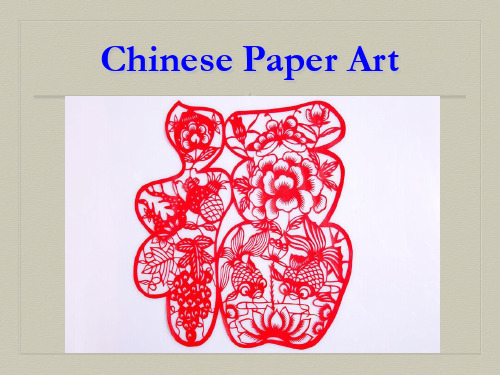
the time of ……时期/年代,time 时代 时期
他自幼学习剪纸。
learned to do 学着去做
Paragraph two
“It is a Chinese folk art with a long history,” Mr Chen told me, “Paper cuts of animals have been found in tombs which date back to the time of the Northern and Southern Dynasty!”
People think these paper cuts can bring _g_o_o_d_ _lu_c_k_ to them. Paper cuts which feature the Chinese _c_h_a_ra_c_t_e_r for double happiness are commonly used to _ce_l_e_b_r_a_te_ w__e_d_d_in_g_s_. Another type of paper cuts is used for r_e_li_g_i_o_u_s purposes. A third kind of paper cuts is used in the d_e_s_i_g_nof other crafts.
Chinese Paper Art
People
Mouse
Animals
Cattle
Tiger
Rabbit
Dragon
Snake
Horse
Sheep
Monkey
Rooster
Pig
Dog
Chinese characters
汉字
他自幼学习剪纸。
learned to do 学着去做
Paragraph two
“It is a Chinese folk art with a long history,” Mr Chen told me, “Paper cuts of animals have been found in tombs which date back to the time of the Northern and Southern Dynasty!”
People think these paper cuts can bring _g_o_o_d_ _lu_c_k_ to them. Paper cuts which feature the Chinese _c_h_a_ra_c_t_e_r for double happiness are commonly used to _ce_l_e_b_r_a_te_ w__e_d_d_in_g_s_. Another type of paper cuts is used for r_e_li_g_i_o_u_s purposes. A third kind of paper cuts is used in the d_e_s_i_g_nof other crafts.
Chinese Paper Art
People
Mouse
Animals
Cattle
Tiger
Rabbit
Dragon
Snake
Horse
Sheep
Monkey
Rooster
Pig
Dog
Chinese characters
汉字
中国古典艺术 ppt课件
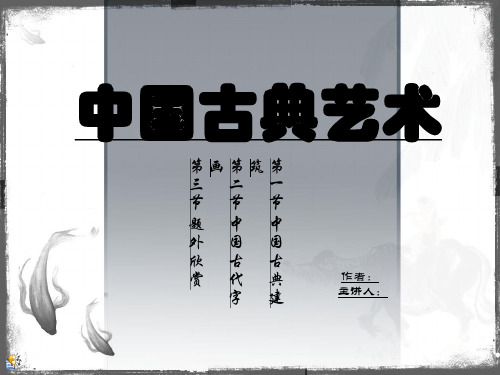
中国古典艺术 “骑凤仙人”,民间也叫做“仙人骑鸡”。这个“仙人”究竟
是谁?为什么在檐角的最前端?为什么骑着凤凰?民间对此有着 各种各样的传说。 一种传说他是姜子牙的小舅子,想利用姜 子牙的关系往上爬。姜子牙看出小舅子的居心,但深知道他才能 有限,因此对他说:“你的官已升到顶了,如果再往上爬就会摔 下来。”古代的建筑师们根据这个传说,把他放在了檐角的最前 端,如果再往上爬一步就会掉下去摔得粉身碎骨。 另一种传 说他是齐泯王,在位期间不务正业,昏庸无道,所以遭到群众的 憎恨,珍禽异兽穷追猛打,把他追到走投无路的地步,再往前迈 一步,就会掉下来摔得粉身碎骨。
, 此 外 还 有 附 近 的 畅 春 园 和 圆 明
别 建 有 三 园 静 明 园 、 静 宜 园 、 颐 和
万 寿 山 、 香 山 和 玉 泉 山 。 三 座 山 上
前 身 清 漪 园 , 是 三 山 五 园 ( 三 山 是
颐 和 园 原 是 清 朝 帝 王 的 行 宫 和 花 园
中国古典艺术
中国古典艺术
中国古典艺术
中国古典艺术
•天坛
体 仁 阁
万 寿 山
中国古典艺术
中国古典艺术
中国古典艺术
中国古典艺术
白金汉宫宫由”白。金这汉是公19世爵纪兴前建期,的故豪称华“式白建金筑汉
风格,庞大的规模甚至比华丽的外表 更加引人注目
威斯敏斯特宫
威斯敏斯特宫(Palace of Westminster),又 称国会大厦(Houses of Parliament)是英国国会 (包括上议院和下议院) 的所在地。威斯敏斯特 宫是哥德复兴式建筑的 代表作之一
中国古典艺术
第画第筑第 三二一 节节节
题中中 外国国 欣古古 赏代典
中国传统艺术-ppt
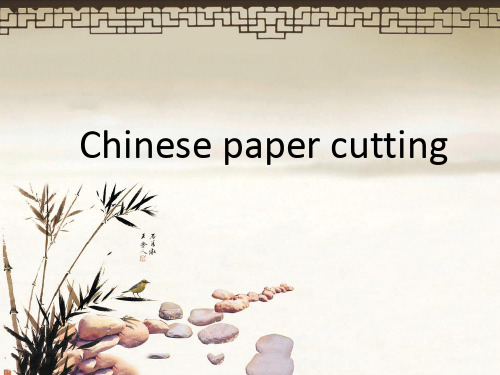
• From the 7th to 13th century, paper cutting became popular especially during Chinese holiday festivals. The art spread to the rest of the world in the 14th century. Throughout the Qing Dynasty many paper cutting skills were developed including drafting and the use of smoked papers. By the end of the Qing ruling however, new art forms were being introduced.
Chinese paper cutting
• Chinese Paper cutting is a picture cut out on a paper with scissors. The picture patterns are often pasted on the windows, or lanterns to express the feelings of joy and the perceptions in life. Hence the scissors-cut is also known as “scissorspicture” or ”paper-cut for window decoration”. •
• 从7世纪,到13世纪,剪 纸开始流行特别是在中 国节日节日期间。在14 世纪的时候,剪纸还艺 术传播到世界其他地方。 在清朝时期,剪纸艺术 不断发展包括烟熏纸和 纸抽的使用。然而,在 清朝统治末期,新的艺 术形式开始被引进来。
第七章中国传统艺术ppt课件
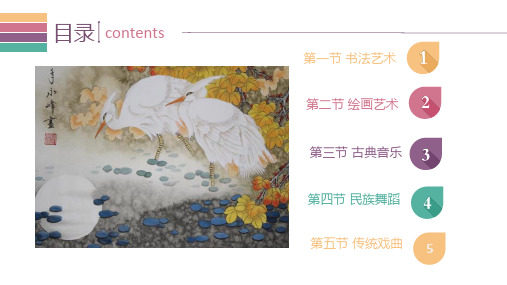
中国传统音乐融合了儒释道思想的精华,注重通过有限的自然形态来传达无限的生命意蕴,在虚实相生、有无统一、形神兼备、情景交融的基础上追求象外之象、景外之景和言外之意,强调隽永的韵味。在艺术形式上没中过传统音乐崇尚中和、典雅之美,节奏舒缓、轻悠,曲调“乐而不淫,哀而不伤”。
目录
contents
(一)雅乐
元
明代,北方杂剧逐渐衰落,南方戏曲吸收杂剧优点,演变为“传奇”。
明
清
清代中国戏曲发展的鼎盛时期,清代中叶,因乾隆皇帝的喜爱,昆曲进入北京,成为诸多声腔中的佼佼者。
昆曲
产生于明代的一种新型戏剧样式。明朝前期,南戏形成了四大声腔:昆山腔、弋(Yi)阳腔、海盐腔和余姚腔。
京剧作为中国戏曲的突出代表,具有高度综合性和程式性。
目录
contents
一、墨出五彩
在中国画里,“墨”并不是只被看成一种黑色。在一幅水墨画里,即使只用单一的墨色,也可使画面产生色彩的变化,完美地表现物象。“墨分五色”,那墨色有 “干、湿、浓、淡、焦”五种,如果加上“白”,就是“六彩”。其中“干”与“湿”是水分多少的比较;“浓”与“淡”是色度深浅的比较;“焦”,在色度上深于“浓”;“白”,指纸上的空白,二者形成对比。
(一)气势
(二)意态
(三)韵律
第二节 绘画艺术
中国的绘画最早可上溯至新石器时代,早期的绘画形式有彩陶纹饰和岩画,而后又出现了青铜纹饰、秦汉壁画、汉代帛画、画像石等。东汉时期,纸的发明为中国画创造了良好的载体。魏晋南北朝时,中国画开始迈入自觉的艺术门槛,出现了顾恺之、张僧繇、谢赫等一批画家和绘画理论家,这标志着中国画成为一门独特的艺术。
汉
汉代是中国舞蹈繁荣发展的时期。西汉初年,儒术独享,庙堂乐舞以法定的地位得以流传。与此同时,汉代世俗的乐舞也得到了极大的普及,出现了从君主到臣民的歌舞热潮。
目录
contents
(一)雅乐
元
明代,北方杂剧逐渐衰落,南方戏曲吸收杂剧优点,演变为“传奇”。
明
清
清代中国戏曲发展的鼎盛时期,清代中叶,因乾隆皇帝的喜爱,昆曲进入北京,成为诸多声腔中的佼佼者。
昆曲
产生于明代的一种新型戏剧样式。明朝前期,南戏形成了四大声腔:昆山腔、弋(Yi)阳腔、海盐腔和余姚腔。
京剧作为中国戏曲的突出代表,具有高度综合性和程式性。
目录
contents
一、墨出五彩
在中国画里,“墨”并不是只被看成一种黑色。在一幅水墨画里,即使只用单一的墨色,也可使画面产生色彩的变化,完美地表现物象。“墨分五色”,那墨色有 “干、湿、浓、淡、焦”五种,如果加上“白”,就是“六彩”。其中“干”与“湿”是水分多少的比较;“浓”与“淡”是色度深浅的比较;“焦”,在色度上深于“浓”;“白”,指纸上的空白,二者形成对比。
(一)气势
(二)意态
(三)韵律
第二节 绘画艺术
中国的绘画最早可上溯至新石器时代,早期的绘画形式有彩陶纹饰和岩画,而后又出现了青铜纹饰、秦汉壁画、汉代帛画、画像石等。东汉时期,纸的发明为中国画创造了良好的载体。魏晋南北朝时,中国画开始迈入自觉的艺术门槛,出现了顾恺之、张僧繇、谢赫等一批画家和绘画理论家,这标志着中国画成为一门独特的艺术。
汉
汉代是中国舞蹈繁荣发展的时期。西汉初年,儒术独享,庙堂乐舞以法定的地位得以流传。与此同时,汉代世俗的乐舞也得到了极大的普及,出现了从君主到臣民的歌舞热潮。
中国传统艺术中英文介绍sophia ppt课件

Traditional food, Traditional costume. Etc. China, a ancient
country of over 5,000 years of history and cultural tradition,
has a profound traditional cultural foundation
,手工艺者,诗人,建筑师等在中国的历史
长河中,通过他们对中国人、社会和环境的
理解所呈现给我们的,反映中国社会历史生
活的一幅文化长卷。In the long history of
China, Chinese traditional art is that the
generations of Chinese painter,
made by cutting paper with sci ssors to form different pattern s and pasting them on walls, wi ndows, doors and ceilings.
•剪纸,顾名思义, 就是用剪刀把纸剪
出各种图形,并且
把它们贴在墙上、
→草书grass script
calligraphy
→行书running hand ( in Chinese
ppt课件
19
甲骨文 Oracle Bone Script
ppt课件
20
篆书 Seal script
ppt课件
21
金文 Inscriptions on bronze
ppt课件
22
隶书和楷书 Calligraphy and script
ppt课件
16
中国传统文化PPT课件ppt

创新和发展
在传承和弘扬传统文化的基础上,注重创新和发展,结合时代特 征和需求,推动中国传统文化的现代化发展。
提高全民文化素质
通过各种途径和形式,提高全民的文化素质和审美水平,增强对 中国传统文化的认知和理解,为传统文化的传承和发展奠定坚实 的基础。
05
中国传统文化在当代的应用与实践
在教育中的应用
习俗
不同地区的习俗各异,如春节期间北方习惯吃饺子,而南方则更喜欢年糕。端午节时,南 方赛龙舟、吃粽子,而北方则较少见。
建筑风格
中国的建筑风格因地域不同而千差万别。例如,南方的房屋多以高脚楼为主,注重通风和 防潮;而北方的四合院则注重保暖和封闭性。
地域文化差异的形成原因
01
地理环境
各地的地理环境如气候、地形等对地域文化产生了重要影响。例如,
VS
内涵
中国传统文化内涵丰富,包括哲学思想、 道德伦理、文学艺术、科学技术等多个方 面。其中,儒家思想是传统文化的主流, 强调以人为本、仁爱和谐;道家思想则注 重自然与人的和谐,追求内心的平静与宇 宙的奥秘;佛教文化则强调修身养性、慈 悲为怀,追求解脱生死。
历史与起源
历史
中国传统文化源远流长,可以追溯到公元前2000多年的夏商 时期。在漫长的历史长河中,中华民族经历了多次文化交流 与融合,形成了多元一体的文化格局。
中国传统文化也对韩国文化产生了影响,例如儒家思想、道家思想等。
对世界文化的影响与贡献
对世界文化的贡献
中国传统文化中的许多元素已经被世界各地的人们所接受和 认同,例如中医、武术、书法等。
对世界文化的影响
中国传统文化对世界文化的影响是不可忽视的,例如儒家思 想、道家思想等对世界各地哲学、社会政治和宗教的发展都 产生了深远的影响。
在传承和弘扬传统文化的基础上,注重创新和发展,结合时代特 征和需求,推动中国传统文化的现代化发展。
提高全民文化素质
通过各种途径和形式,提高全民的文化素质和审美水平,增强对 中国传统文化的认知和理解,为传统文化的传承和发展奠定坚实 的基础。
05
中国传统文化在当代的应用与实践
在教育中的应用
习俗
不同地区的习俗各异,如春节期间北方习惯吃饺子,而南方则更喜欢年糕。端午节时,南 方赛龙舟、吃粽子,而北方则较少见。
建筑风格
中国的建筑风格因地域不同而千差万别。例如,南方的房屋多以高脚楼为主,注重通风和 防潮;而北方的四合院则注重保暖和封闭性。
地域文化差异的形成原因
01
地理环境
各地的地理环境如气候、地形等对地域文化产生了重要影响。例如,
VS
内涵
中国传统文化内涵丰富,包括哲学思想、 道德伦理、文学艺术、科学技术等多个方 面。其中,儒家思想是传统文化的主流, 强调以人为本、仁爱和谐;道家思想则注 重自然与人的和谐,追求内心的平静与宇 宙的奥秘;佛教文化则强调修身养性、慈 悲为怀,追求解脱生死。
历史与起源
历史
中国传统文化源远流长,可以追溯到公元前2000多年的夏商 时期。在漫长的历史长河中,中华民族经历了多次文化交流 与融合,形成了多元一体的文化格局。
中国传统文化也对韩国文化产生了影响,例如儒家思想、道家思想等。
对世界文化的影响与贡献
对世界文化的贡献
中国传统文化中的许多元素已经被世界各地的人们所接受和 认同,例如中医、武术、书法等。
对世界文化的影响
中国传统文化对世界文化的影响是不可忽视的,例如儒家思 想、道家思想等对世界各地哲学、社会政治和宗教的发展都 产生了深远的影响。
相关主题
- 1、下载文档前请自行甄别文档内容的完整性,平台不提供额外的编辑、内容补充、找答案等附加服务。
- 2、"仅部分预览"的文档,不可在线预览部分如存在完整性等问题,可反馈申请退款(可完整预览的文档不适用该条件!)。
- 3、如文档侵犯您的权益,请联系客服反馈,我们会尽快为您处理(人工客服工作时间:9:00-18:30)。
Chinese Art
Unit 6-2
Chinese art : A brief introduction
• Chinese art has varied throughout its ancient history, divided into periods by the ruling dynasties of China and changing technology. Different forms of art have been influenced by great philosophers, teachers, religious figures and even political leaders. Chinese art encompasses fine arts, folk arts and performance arts.
Gu Kaizhi (顾恺之)
• Gu Kaizhi (顾恺之,ca. 344-406), is a celebrated painter of ancient China. His style name was 'Changkang' (长康). He was born in Wuxi, Jiangsu province and first painted at Nanjing in 364. He was also a talented poet and calligrapher. He wrote three books about painting theory: On Painting (画论), Introduction of Famous Paintings of Wei and Jin Dynasties (魏晋胜流画赞) and Painting Yuntai Mountain (画云台山记). He wrote: "In figure paintings the clothes and the appearances were not very important. The eyes were the spirit and the decisive factor."
• Gu's art is known today through copies of three silk handscroll paintings attributed to him. Many of the major works are in the hands of foreign museums. They are under protection and care, but it is uncertain if China will ever request their return.
晋 顾恺之:女史箴图
Admonitions of the Instructress to the Palace Ladies
•
晋 顾恺之 洛神赋图卷(宋摹本)
Nymph of the Luo River
Zhan Ziqian (展子虔)
• Zhan Ziqian (展子虔 c. mid to late 6th century) was a famous painter of ancient China from Yangxin county (阳 信县), Shandong province. His birth and death dates are unknown. It is known that in the Sui dynasty (581 – 618) he was appointed to the office of Chaosan Dafu (朝散大 夫) and later of Zhangnei Dudu (帐内都督).
• Artwork in the Ming dynasty perfected color painting and color printing, with a wider color range and busier compositions than Song paintings.
History of the Art
• In early imperial China, porcelain was introduced and was refined to the point that in English the word china has become synonymous with high-quality porcelain.
History of the Art
• Under efforts of masters from the Shanghai School during the late Qing Dynasty, traditional Chinese art reached another climax and continued to the present in forms of the “Chinese painting” (国画). The Shanghai School challenged and broke the literati tradition of Chinese art, while also paying technical homage to the ancient masters and improving on existing traditional techniques.
Porcelain art (Yangshao Culture)
Jade Carving (Hongshan and Liangzhu Culture)
History of the Art
• Around the 1st century AD, Buddhism arrived in China, though it did not become popular until the 4th century. At this point, Chinese Buddhist art began to flourish, a process which continued through the 20th century. It was during the period of Imperial China that calligraphy and painting became highly appreciated arts in court circles, with a great deal of work done on silk until well after the invention of paper.
Terracotta Army (兵马俑)
• The terracotta figures, dating from 210 BC, were discovered in 1974 by some local farmers near Xi'an, Shaanxi province, China near the Mausoleum of the First Qin Emperor. (秦始皇陵). The figures vary in height (183–195 cm - 6 ft– 6 ft 5in), according to their role.
西汉霍去病墓石雕 东汉马踏飞燕(甘肃张掖出土)
隋朝的鎏金菩萨像
山西五台山南禅寺唐代彩塑
元代释迦牟尼白瓷佛像
明代鎏金观音坐像
History of the Art
• Buddhist architecture and sculpture thrived in the Sui and Tang dynasty. Of which, the Tang Dynasty was particularly open to foreign influence. Buddhist sculpture returned to a classical form, inspired by Indian art of the Gupta period. Towards the late Tang dynasty, all foreign religions were outlawed to support Taoism.
《溪山楼观图》燕文贵 卷
History of the Art
• In the Yuan dynasty, painting by the Chinese painter Zhao Mengfu (趙孟頫) greatly influenced later Chinese landscape painting.
• According to the historical documents, he painted a number of genres and religion paintings which have not survived. He was especially noted for his paintings of pavilions and people, and horses. His paintings of people were particularly lifelike. The only painting by him that survives today is Strolling About in Spring, which is a perspective arrangement of mountains.e Song Dynasty, paintings of more subtle expression of landscapes appeared, with blurred outlines and mountain contours which conveyed distance through an impressionistic treatment of natural phenomena. It was during this period that in painting, emphasis was placed on spiritual rather than emotional elements, as in the previous period.
Unit 6-2
Chinese art : A brief introduction
• Chinese art has varied throughout its ancient history, divided into periods by the ruling dynasties of China and changing technology. Different forms of art have been influenced by great philosophers, teachers, religious figures and even political leaders. Chinese art encompasses fine arts, folk arts and performance arts.
Gu Kaizhi (顾恺之)
• Gu Kaizhi (顾恺之,ca. 344-406), is a celebrated painter of ancient China. His style name was 'Changkang' (长康). He was born in Wuxi, Jiangsu province and first painted at Nanjing in 364. He was also a talented poet and calligrapher. He wrote three books about painting theory: On Painting (画论), Introduction of Famous Paintings of Wei and Jin Dynasties (魏晋胜流画赞) and Painting Yuntai Mountain (画云台山记). He wrote: "In figure paintings the clothes and the appearances were not very important. The eyes were the spirit and the decisive factor."
• Gu's art is known today through copies of three silk handscroll paintings attributed to him. Many of the major works are in the hands of foreign museums. They are under protection and care, but it is uncertain if China will ever request their return.
晋 顾恺之:女史箴图
Admonitions of the Instructress to the Palace Ladies
•
晋 顾恺之 洛神赋图卷(宋摹本)
Nymph of the Luo River
Zhan Ziqian (展子虔)
• Zhan Ziqian (展子虔 c. mid to late 6th century) was a famous painter of ancient China from Yangxin county (阳 信县), Shandong province. His birth and death dates are unknown. It is known that in the Sui dynasty (581 – 618) he was appointed to the office of Chaosan Dafu (朝散大 夫) and later of Zhangnei Dudu (帐内都督).
• Artwork in the Ming dynasty perfected color painting and color printing, with a wider color range and busier compositions than Song paintings.
History of the Art
• In early imperial China, porcelain was introduced and was refined to the point that in English the word china has become synonymous with high-quality porcelain.
History of the Art
• Under efforts of masters from the Shanghai School during the late Qing Dynasty, traditional Chinese art reached another climax and continued to the present in forms of the “Chinese painting” (国画). The Shanghai School challenged and broke the literati tradition of Chinese art, while also paying technical homage to the ancient masters and improving on existing traditional techniques.
Porcelain art (Yangshao Culture)
Jade Carving (Hongshan and Liangzhu Culture)
History of the Art
• Around the 1st century AD, Buddhism arrived in China, though it did not become popular until the 4th century. At this point, Chinese Buddhist art began to flourish, a process which continued through the 20th century. It was during the period of Imperial China that calligraphy and painting became highly appreciated arts in court circles, with a great deal of work done on silk until well after the invention of paper.
Terracotta Army (兵马俑)
• The terracotta figures, dating from 210 BC, were discovered in 1974 by some local farmers near Xi'an, Shaanxi province, China near the Mausoleum of the First Qin Emperor. (秦始皇陵). The figures vary in height (183–195 cm - 6 ft– 6 ft 5in), according to their role.
西汉霍去病墓石雕 东汉马踏飞燕(甘肃张掖出土)
隋朝的鎏金菩萨像
山西五台山南禅寺唐代彩塑
元代释迦牟尼白瓷佛像
明代鎏金观音坐像
History of the Art
• Buddhist architecture and sculpture thrived in the Sui and Tang dynasty. Of which, the Tang Dynasty was particularly open to foreign influence. Buddhist sculpture returned to a classical form, inspired by Indian art of the Gupta period. Towards the late Tang dynasty, all foreign religions were outlawed to support Taoism.
《溪山楼观图》燕文贵 卷
History of the Art
• In the Yuan dynasty, painting by the Chinese painter Zhao Mengfu (趙孟頫) greatly influenced later Chinese landscape painting.
• According to the historical documents, he painted a number of genres and religion paintings which have not survived. He was especially noted for his paintings of pavilions and people, and horses. His paintings of people were particularly lifelike. The only painting by him that survives today is Strolling About in Spring, which is a perspective arrangement of mountains.e Song Dynasty, paintings of more subtle expression of landscapes appeared, with blurred outlines and mountain contours which conveyed distance through an impressionistic treatment of natural phenomena. It was during this period that in painting, emphasis was placed on spiritual rather than emotional elements, as in the previous period.
